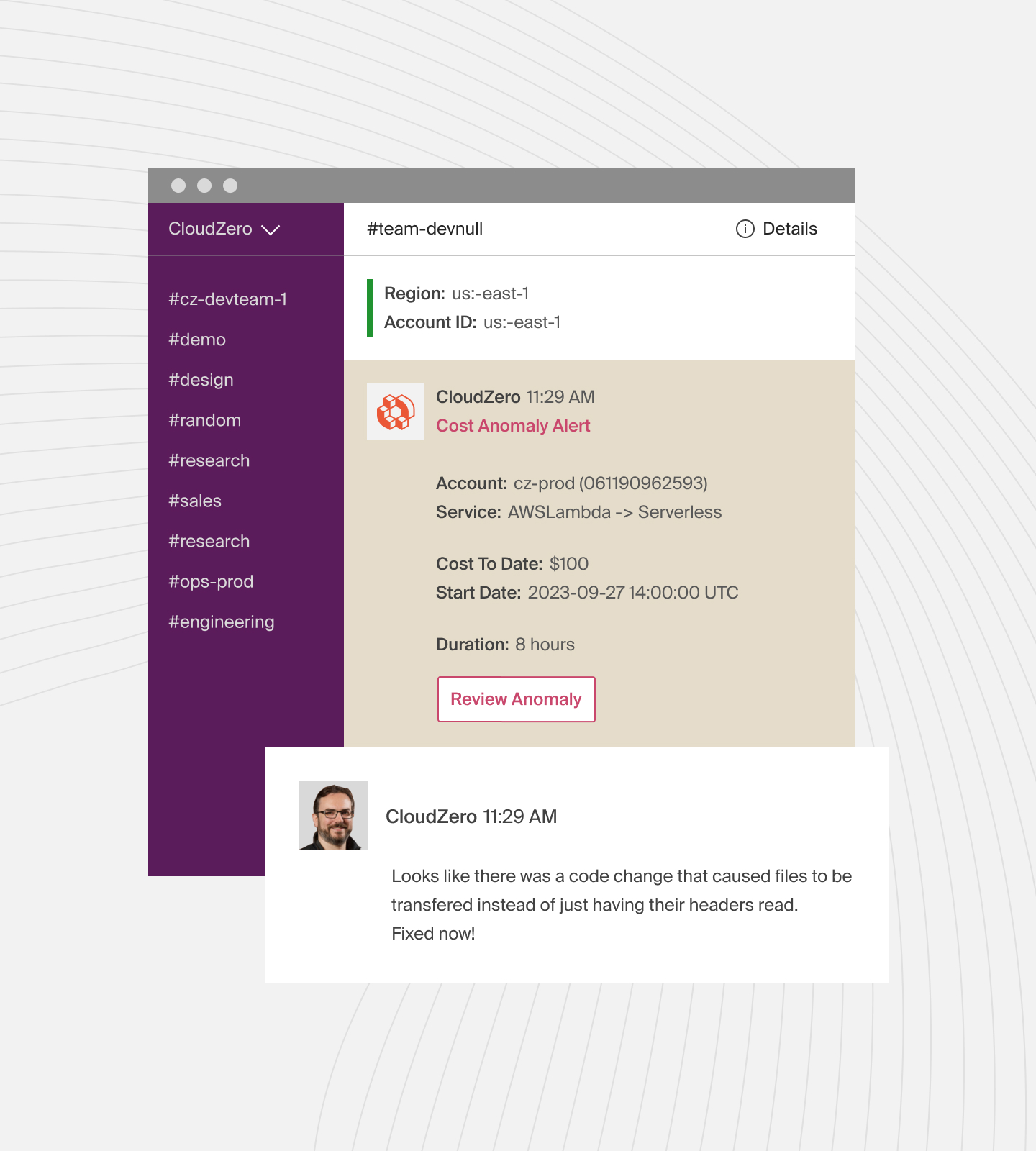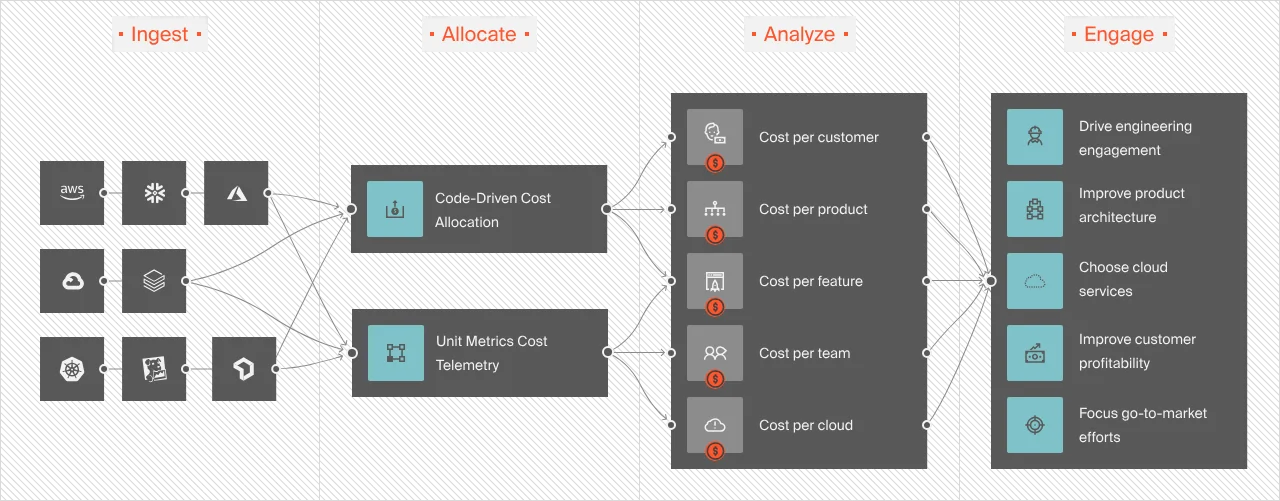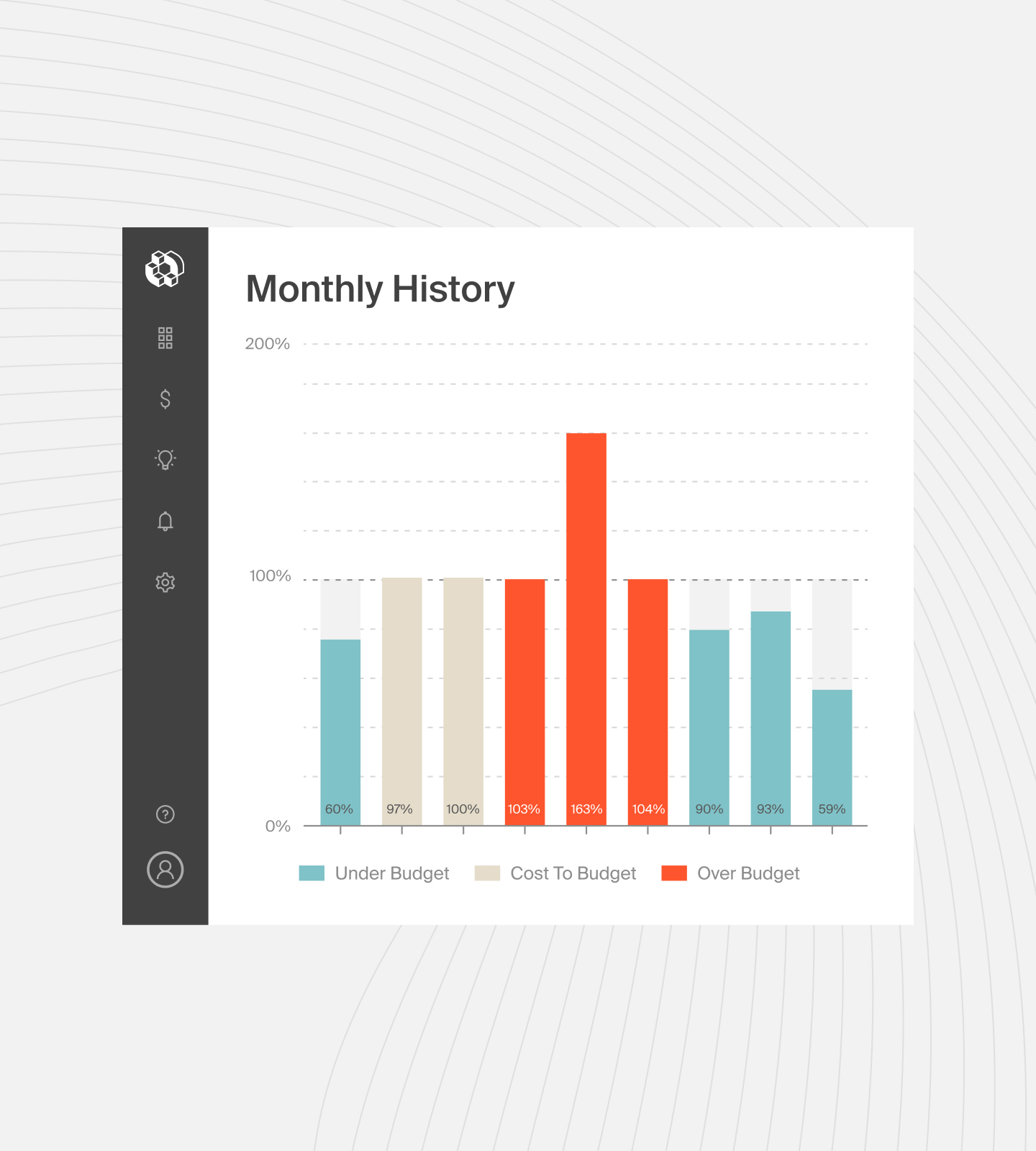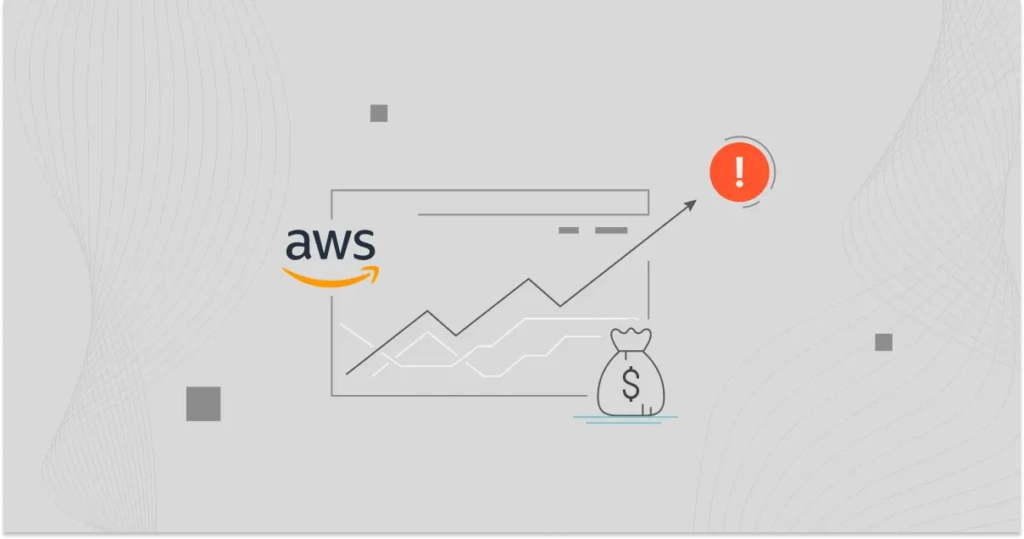Picture a fast-growing company that depends heavily on AWS for its infrastructure but doesn’t use AWS Budget Alerts. One month, they received an AWS bill 50% higher than expected. Without any warnings, they could not address the cost anomalies in real time. This led to budget overruns and strained financial planning. The engineering team couldn’t explain to the finance operations how that happened.
This situation highlights the need for AWS Budget Alerts.
In this article, we explain what AWS Budget Alerts are, how to configure them, and why they are crucial for reaching your FinOps goals. We’ll also introduce you to CloudZero’s cost anomaly detection and how it takes cost management to the next level.
What Are AWS Budgets?
AWS Budget Alerts is an AWS cost management tool that helps you plan and manage your AWS costs and usage.
With AWS Budgets, you can create custom budgets for various needs. This includes:
- Monitoring your actual and forecasted costs against your budget
- Tracking your usage of your AWS services
- Keeping an eye on the use of your reserved instances
- Offering detailed reporting and insights into your spending patterns
Users can set up alerts to get an email or SMS when their costs or usage go over their budget. This includes both actual and forecasted costs and usage. Additionally, AWS Budgets integrates with AWS Cost Explorer to enable users to visualize their costs and usage.
Read our guide here to learn how to analyze and better understand your spending data using Cost Explorer.
What to Consider When Setting Your AWS Budget
When setting your AWS Budget, several major factors can help you control and optimize your cloud spending. Here is what to consider
Understand your current AWS usage and costs
Before setting an AWS Budget, it’s important to clearly understand your current AWS usage and costs. This involves:
Analyzing past usage. Analyze your historical data to detect patterns in your usage and costs. You can use AWS Cost Explorer here to visualize and understand your spending trends over a period of time.
Identifying the major cost drivers. Determine which AWS services or resources that immensely contribute to your AWS bill. This can help you focus on areas where you might be able to optimize and save costs.
Define clear objectives
Setting an AWS Budget requires clear objectives for your organization’s goals. Consider the following:
- Cost control. Set spending limits to prevent budget overruns and ensure financial discipline.
- Resource optimization. Aim to improve the efficiency of your resource usage. Eliminate waste and optimize performance.
- Forecasting and planning. Use the AWS budget for better financial planning and forecasting future costs.
Categorize your budget
Break down your AWS budget into different categories to better manage and monitor your costs. Some of the primary categories include:
- By service. Allocate budgets for various AWS services. These could include Amazon S3, Amazon EC2, among others.
- By project or department. Set budgets for different projects, departments, or teams within your organization.
- By environment. Differentiate budgets for production, development, and testing environments.
Set realistic budgets in AWS
Setting a realistic budget is essential. Consider setting the following budgets in AWS:
- Usage budgets. Define thresholds based on usage metrics like the number of compute hours, storage used, or data transferred.
- Cost budgets. Set limits on each dollar spent on specific services or the overall AWS usage.
- Time-based budgets. Implement monthly or quarterly budget limits to monitor and control costs over specific periods.
- Savings plans and Reserved Instances (RI) utilization budgets. Monitor the usage of your Savings Plans and Reserved Instances to ensure you get the most value out of them.
- Savings Plans and Reserved Instances (RI) coverage budgets. These guarantees that a large percentage of your usage is included in pricing plans with discounts.
Monitor and adjust regularly
Regular monitoring and adjustments are essential to stay within your budget. Ensure you:
- Track spending in real time. AWS Budgets along with AWS Cost Explorer to monitor your spending in real-time. You’ll receive alerts when you approach your budget limits.
- Review and adjust budgets periodically. Regularly review your budgets. Adjust them based on changes in use, new projects, or your organization’s needs.
- Involve stakeholders. Ensure that all the right people are involved, including finance, operations, and development teams.
Use AWS tools and features
Other than AWS Budgets and AWS Cost Explorer. AWS also offers other tools to help you set and manage your budget effectively. These include:
- AWS Cost and Usage Reports. The reports contain detailed data on your AWS costs and usage. They help you to dive into your spending.
- AWS Trusted Advisor. This service gives real-time guidance. It helps you optimize your AWS environment, improve performance, and cut costs.
Check out our guide on other Best AWS Cost Optimization Tools.
Consider external factors
When setting your budget, consider external factors such as:
- Market trends. Stay updated on AWS pricing updates, new services, and market trends that may impact your costs.
- Regulatory requirements. Make sure your budget accounts for any compliance and regulatory requirements. They may require extra spending on security, backups, or data storage.
- Business growth. Factor in expected business growth and scaling needs, which may increase your AWS usage and costs over time.
Implement governance and best practices
Some of the governance policies and best practices that can help you control your AWS budget include:
- Tagging resources. Use a tagging strategy to categorize and track your resources. It will help allocate and manage costs better.
- Governance policies. Create and enforce policies for getting, using, and removing resources. This will avoid unnecessary costs.
- Education and training. Educate your teams about AWS costs and budgeting best practices. This will ensure everyone knows their role in managing cloud spending.
How AWS Budget Alerts Can Help Your FinOps Goals
While AWS Budget Alerts is not exactly a FinOps tool, it still significantly supports FinOps practices. Here’s how AWS Budget Alerts can enhance your FinOps strategy:
- Enhanced financial accountability. Integrating AWS Budget Alerts into your FinOps strategy can improve financial accountability across teams. AWS Budget Alerts can notify teams about their spending by setting separate budgets for different departments or projects. This increased visibility into spending helps teams understand their financial impact and encourages more thoughtful use of resources.
- Optimization of cloud resources. AWS Budget Alerts provide insights that lead to better optimization of cloud resources. By understanding where and how your budget is spent, you can make informed decisions about resources. Alerts about unexpected spikes in costs can indicate inefficient resource use. This allows you to identify and fix issues such as over-provisioned instances or underutilized services. Regular alerts and reports can also reveal where cost-saving measures can be implemented.
- Supporting strategic financial planning. AWS Budget Alerts integrate with your financial planning processes, allowing you to make strategic decisions using accurate and timely financial data. Historical data and trends from AWS Budget Alerts can be used to create more accurate future budgets. Predicted spending data can be utilized to plan for future costs, ensuring efficient use of resources.
- Integration with AWS cost management tools. Using AWS Budget Alerts along with AWS Cost Explorer gives more detailed information about how you are spending money, enabling you to spot opportunities to save costs. AWS Cost and Usage Reports, in conjunction with AWS Budget Alerts, ensure in-depth analysis of spending through detailed reports.
- Facilitating FinOps practices. AWS Budget Alerts are instrumental in facilitating key FinOps practices. Regular monitoring and alerts enable continuous assessment and improvement of cloud spending practices. Alerts and reports foster collaboration, bringing together finance, operations, and development. This ensures alignment towards the common goal of cost efficiency. Additionally, AWS Budget Alerts provide timely and relevant data, educating teams about their cloud spending, promoting a culture of cost awareness and accountability.
How to Set Up AWS Budget Alerts
Here are quick steps to set up these alerts efficiently:
Step 1: Login into AWS Management Console to access AWS Budgets. Access the Billing and Cost Management Dashboard by choosing “Billing and Cost Management” from the services menu.
Step 2. Navigate to the dashboard, select “Budgets” in the sidebar, and then click on the option to “Create budget.” You will be asked to select the category of budget you wish to make: Cost Budget, Usage Budget, or Reservation Budget.
Step 3. Provide the information needed for your budget by specifying the budget name. Select the duration (monthly, quarterly, or annually), and indicate the start and end dates. Afterward, indicate the budget levels by inputting the desired budget amount, which may be a set figure or determined based on actual costs or usage trends. Choose the alert thresholds by selecting the desired levels to receive alerts.
Step 4: Specify if the alert is for actual or predicted costs. Set up notification preferences by inputting email addresses for receiving alerts.
Step 5: Regularly monitor your AWS Management Console budgets to ensure you do not exceed your set limits. Adjust budgets and alerts if your spending patterns change or if you add new projects or services.
After that, you are all set.
Elevate Your AWS Budget Management with CloudZero
AWS Budget Alerts is robust in tracking and managing cloud spending. But, CloudZero takes cloud cost management to the next level through tailored solutions. These include:
Real time cost anomaly detection
One of Cloudzero’s distinctive features is its real time cost anomaly detection. Traditional AWS Budget Alerts will inform you when you are nearing or surpassing your budget limit. CloudZero takes it a step further by identifying unforeseen spending patterns in real time. This allows your team to quickly address cost overruns before they escalate into major problems. By detecting anomalies early, you can control your budget and avoid surprise charges on your bill.

Advanced cost visibility
CloudZero provides unmatched visibility into your cloud costs. It does this by aligning them with your business metrics. This unique approach allows you to see costs per feature, product, customer, team, and cloud. Unlike traditional tools, CloudZero’s detailed visibility helps you understand how each part of your business adds to your cloud costs. This empowers teams to make informed decisions about resource use and cost efficiency.

Historical data analysis
CloudZero offers robust historical data analysis. This allows teams to track cost trends over time and make informed budgeting decisions. By understanding past spending patterns, you can forecast future costs more accurately. You can also identify opportunities for cost savings through historical data analysis.

FinOps alignment
CloudZero is a FinOps-certified platform that offers the tools and insights needed to align cloud spending with business goals. The platform’s cost management features enable organizations to have more financial control and efficiency, making It an essential tool of any FinOps strategy.
CloudZero has a proven track record of helping organizations manage and optimize their cloud costs. For example, LawnStarter reduced its cloud storage costs by 50%. NinjaCat lowered its cloud costs by 40%, and Upstart saved a significant $20 million. But don’t just take our word for it.  to see how CloudZero can revolutionize your approach to managing cloud costs.
to see how CloudZero can revolutionize your approach to managing cloud costs.








